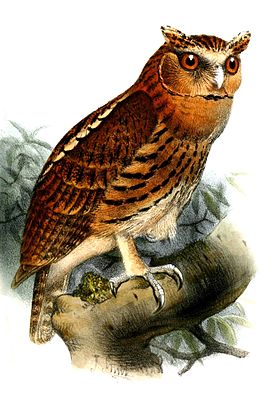Red-eared owl
| Red-eared owl | ||||||||||
|---|---|---|---|---|---|---|---|---|---|---|

Red-eared Owl ( Mimizuku gurneyi ) |
||||||||||
| Systematics | ||||||||||
|
||||||||||
| Scientific name of the genus | ||||||||||
| Mimizuku | ||||||||||
| Hachisuka , 1934 | ||||||||||
| Scientific name of the species | ||||||||||
| Mimizuku Gurneyi | ||||||||||
| ( Tweeddale , 1879) |
The red-eared owl ( Mimizuku gurneyi , Syn .: Otus gurneyi ) is a fairly large, relatively high-contrast colored owl species from the family of real owls (Strigidae). The genus Mimizuku is monotypical with the red-eared owl as the only species. It is endemic to the Philippines and is restricted to the four islands of Mindanao , Dinagat , Siargao and Samar , but there is only one record of Samar. The species inhabits the primeval tropical rainforest , secondary forest and also dipterocarp forests, which wood has been selectively removed from, which is dominated by wing fruits (Dipterocarpaceae) . Practically nothing is known about the way of life of the red-eared owl. It is classified by the IUCN as endangered (" vulnerable ") due to the rapidly progressing forest destruction .
description
Red-eared owls are quite large owls with long feather ears and strong legs and toes, which are feathered to the base of the toes, and large claws. The body length is 30-35 cm, they are slightly smaller than a long-eared owl . There is no information on weight. The sexes do not differ in terms of coloration, but the species shows a clear sex dimorphism, at least in terms of body size. So females have a wing length up to 274 mm, males reach only 217–242 mm.
The coloring is quite contrasting. In adult birds, the upper side of the trunk is dark red-brown with black shaft lines. The outer flags of the shoulder feathers are whitish beige with blackish edges. The upper wing-coverts are rather dark brown and also show black shaft lines. Wings and tail are banded light beige brown and dark brown. The chest and flanks show strong teardrop-shaped or oval black spots on a pale red-brown background, the belly is white and unmarked.
The eyebrows are broadly whitish, outwardly more beige; the feather ears are spotted reddish brown and black. The face veil is light reddish brown and narrowly bordered with black spots. The rest of the head and the neck, like the top of the trunk, are dark red-brown with black lines on the shaft. The beak is greenish yellow to grayish white. The featherless toes are pale gray-brown, the claws pale horn-colored with black tips. The iris is brown. The appearance of the young birds has not yet been described. No subspecies are recognized.
Vocalizations
The male's courtship and territory song is a series of rumbling, somewhat melancholy sounding calls, which are often repeated 5 to 10 times at intervals of 10 to 20 seconds and sound like "wuoohk wuoohk ..." . The individual calls drop in pitch. Further calls are not yet known.
distribution and habitat
The red-eared owl is endemic to the Philippines and is restricted to the four islands of Mindanao , Dinagat , Siargao and Samar , but there is only one record of Samar. The total distribution area covers about 108,000 km².
It inhabits the primary and secondary rainforest , which is dominated by wing fruit plants (Dipterocarpaceae), and also Dipterocarp forests from which wood has been selectively removed. The animals are found mainly in the lowlands from sea level to heights of 670 m, occasionally up to 1300 m, according to König and Weick also up to about 1500 m.
Way of life
The species is exclusively nocturnal. The diet is unknown, it probably consists of small vertebrates and larger insects. Call activity is particularly high between February and May. The breeding biology is completely unknown. No nest has been found to date; Eggs and young birds are therefore also unknown.
Existence and endangerment
There is no reliable information on the size of the world population, BirdLife International gives a very rough estimate of 2500–9999 sexually mature individuals. The IUCN assumes a strong decline and a strong fragmentation of the remaining population. The main threat is the rapid destruction of forests throughout the range. By 1988, the forest area on Mindanao had been reduced to 29% of the originally existing area and in 1992, 724 km² of closed forest were still preserved on Samar. For the majority of the remaining forests, licenses for the use of wood or for the search for mineral resources have already been issued. Dinagat has already been almost completely deforested through illegal clearing and the mining of chromite . The Red-eared Owl is therefore classified as endangered (" vulnerable ") by the IUCN .
swell
Individual evidence
- ↑ a b c d BirdLife International (2010) Species factsheet: Mimizuku gurneyi. Online . Retrieved January 1, 2011
- ↑ Claus König, Friedhelm Weick: Owls of the World . Christopher Helm, London 2008, ISBN 978-0-7136-6548-2 : p. 317
literature
- Claus König , Friedhelm Weick: Owls of the World . Christopher Helm, London 2008, ISBN 978-0-7136-6548-2 : pp. 116–117 and 317
Web links
- Otus gurneyi in the endangered Red List species the IUCN 2010. Posted by: BirdLife International, 2008. Accessed on January 1, 2011th
Other web links
- Videos, photos and sound recordings of Mimizuku gurneyi in the Internet Bird Collection